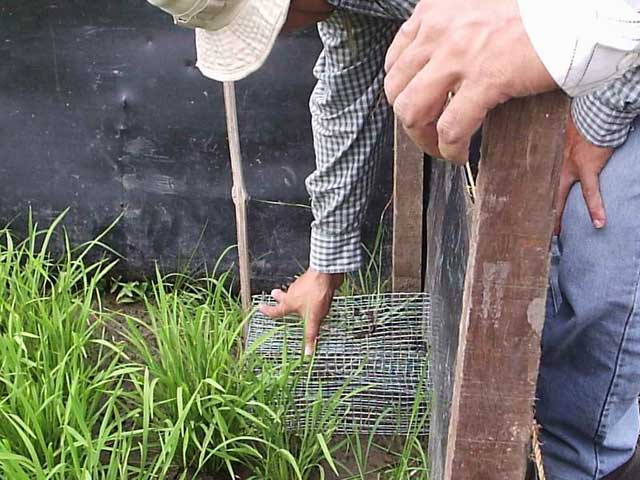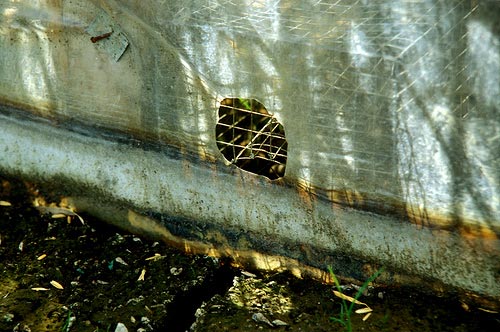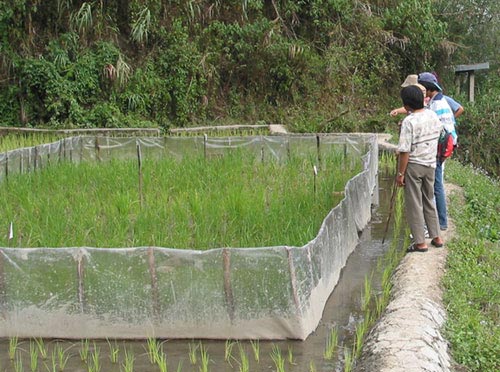Rodent control (non-chemical) in lowland irrigated rice
Which rodents are pests in rice?
 Many rodents cause problems in rice. The main pests are the "Rice field rat" (Rattus argentiventer), the Black rat (Rattus rattus) and the lesser Bandicoot rat (Bandicota bengalensis). Various mice can also cause problems. The presence of rats is usually associated with tracks in mud and rat holes in bunds and levees.
Many rodents cause problems in rice. The main pests are the "Rice field rat" (Rattus argentiventer), the Black rat (Rattus rattus) and the lesser Bandicoot rat (Bandicota bengalensis). Various mice can also cause problems. The presence of rats is usually associated with tracks in mud and rat holes in bunds and levees.
Why control rodents?
Rodents causes significant losses both in the field and in post-harvest rice management.
Keys to effective rodent control - Community action and Understanding rodent biology
 Live trap
Live trap
Typical field symptoms include seed eaten at planting, plant sheaths or tillers cut at 45 degrees near the base, or missing grains or panicles. Droppings and half eaten grain are typical symptoms of rodents in grain stores. Different rat species differ in their breeding patterns and places where they live and thrive. Therefore different control strategies are required for different rodents.
Rice field rats: The breeding of the rice field rat is linked to the development of the rice crop and they give birth to 10-14 young. They begin breeding before panicle initiation and stop when the crop ripens. If crops are planted more than two weeks apart then the rats will move to the late-planted crops and continue breeding. The rats live along channel banks and in village gardens during land preparation. These are target habitats for short, intensive, community control campaigns. The rice field rats are very sensitive to human disturbance and so are rarely found in houses and grain stores.
Black rats: Black rats only give birth to 6-10 young but some females breed for most of the year. They therefore require low level but continual community control actions. The black rat thrives around houses and is a major postharvest pest.
Control for both species requires:
- general hygiene
- community action,
- synchronous planting (plant within two weeks),
- bunds kept to less than 30cm wide where possible,
- reduce amount of cover along edges of rice fields, especially along major irrigation canals and roads
- clean spilled grain at harvest, keep village gardens and around houses clear of rubbish, food scraps
- strategic use of the Trap Barrier System (TBS) - use during the rice season which suffers most damage
Building and maintaining a Trap Barrier System (TBS)
 Trap barrier systemA TBS will have an effect over an area of 200m radius from the TBS (10 ha). A TBS is simple to erect, but to work properly, needs to meet these specifications:
Trap barrier systemA TBS will have an effect over an area of 200m radius from the TBS (10 ha). A TBS is simple to erect, but to work properly, needs to meet these specifications:
What you need are:
- plastic for barrier fence (stronger material will resist damage, withstand high winds and be reusable for several seasons);
- bamboo stakes to support the barrier and traps; string or wire to erect barrier;
- stapler and staples to fix plastic to string or wire;
- multiple capture live-traps; kill traps for use within the 'lure' crop.
How to build a TBS:
- Select an existing 20 to 50 meter square plot within the rice field;
- Use stakes and string to erect fence, bury plastic 10cm into ground and have fence 60 cm above ground;
- Dig or widen existing channels to construct an encircling moat at least half a meter wide;
- Install one or two multiple capture traps along each side (these must be held tightly against the fence, with no holes or gaps that might allow rats to bypass the traps);
- Construct earth mounds partway across the moat, leading to traps;
- Place kill traps along the inside of the fence to catch any rats that climb the barrier; and
- Plant the lure crop 2-3 weeks before the surrounding crop is planted.
TBS maintenance
- empty the traps early each morning (dead rats left in the traps will discourage other rats from entering);
- check the plastic barrier for holes each day and either repair these or install extra traps;
- keep the moat free of grass; cover traps with straw and provide food to keep rats from dying; and
- if unable to check the TBS for a few days, place the straw in the entrance of the traps.